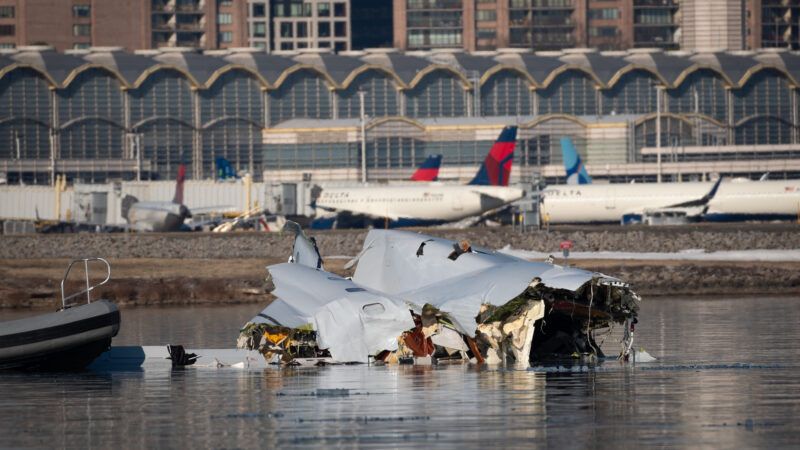Understaffed Air Traffic Control, DEI Are Unlikely Causes of D.C. Plane Crash
There's still a lot we don't know and initial speculation from the media and the president about the causes of Wednesday's disaster appear off-base.

In the immediate aftermath of the deadly collision between an Army Blackhawk helicopter and an American Airlines flight over Washington D.C., people are searching for answers.
The direct cause of the Wednesday night collision, which has tragically left 67 people dead, is not known yet.
Initial reporting has tended to focus on potential error or confusion on the part of the Blackhawk pilot, which resulted in it being "in the wrong place at the wrong time."
The helicopter pilot was flying under visual flight rules (meaning the pilot was using their eyes, not their instruments to avoid other aircraft) and had reported to air traffic control that they could see a regional jet approaching the airport.
An Army spokesperson told The New York Times that the helicopter pilots had experience flying this route near Reagan National Airport and that any assessment about the accident should wait until the Blackhawk's black box is recovered.
The New York Times and Washington Post, both citing a preliminary government accident report that was described to them, report that the air traffic control tower was at below-normal staffing levels and that two controller positions that would have separately handled helicopter and airplane traffic were being manned by one person.
The Post reports that there were only two controllers in the tower instead of the four that would normally be there at that time.
However, current and former air traffic controllers who spoke to Reason said that it is standard for a single controller to be responsible for all local air traffic, including both helicopters and airplanes.
"Unless they have an extremely abnormal operation, I would shoot down the idea that there should have two controllers talking to each airplane," says one current air traffic controller who spoke anonymously to Reason. "I would bet a million dollars that's not the case."
The Army helicopter and the commercial airliner would have been operating on different radio frequencies, but communications with air traffic control would still be handled by one air traffic controller, they said.
Having two separate people in that role "would add a challenge with communications. [You'd] have to communicate with the guy next to you controlling different traffic in the same airspace. That's unsafe," this controller says.
"In my experience it's not" unusual to have one controller to be in charge of both helicopters and airplanes, says Michael Hawks a former Air Force air traffic control tower operator. "It's called local control and they control all the aircraft in the air."
The Federal Aviation Administration's (FAA) manual that describes the positions and responsibilities of air traffic control tower staff does not mention any division of responsibility between helicopter and airplane traffic.
Depending on staffing levels, the FAA manual does say that the role of Tower Position has responsibility for flight separation and traffic flows, but that traffic flows can be handled by a Tower Coordinator if that position is staffed.
The controllers who spoke with Reason say that there is every indication that the air traffic control tower at Reagan was appropriately staffed at the time of the accident.
In the immediate aftermath of Wednesday's tragedy, both President Donald Trump and Vice President J.D. Vance suggested that past diversity hiring initiatives at the FAA might have contributed to the accident.
"This shocking event follows problematic and likely illegal decisions during the Obama and Biden Administrations that minimized merit and competence" at FAA, said a White House press release issued Thursday.
The press release references a now infamous biographical questionnaire for air traffic control applicants adopted under the Obama administration that was intended to diversify the controller applicant pool.
As has been revealed in past reporting and subsequent lawsuits, FAA employees leaked answers to the questionnaire to black applicants to improve their chances of being selected into the FAA's air traffic controller training program.
Applicants who were excluded from that training program because of the questionnaire are currently suing the FAA over alleged race-based discrimination. The use of that biographical questionnaire was ended in 2018.
While using that biographical questionnaire is a legitimate scandal, "there's no evidence that the result of what they're calling the DEI program had a negative impact on the qualifications, the competence of the controller workforce," says Marc Scribner, a transportation researcher at Reason Foundation, the nonprofit that publishes Reason.
The FAA has long had difficulty recruiting enough air traffic controllers, which has created an overall air traffic control staffing shortage.
The causes of this staffing shortage however are many, and many years in the making, say Scribner. Past government shutdowns, budget sequestrations, and competing budgetary priorities within the Department of Transportation, of which the FAA is a part, have reduced the agency's capacity to train a sufficient number of new controllers.
"Although I support the president with what he says mostly, I think what he said was very damaging," said the current controller who spoke with Reason in reference to Trump's Thursday morning comments about the accident.
Safety concerns about military helicopter flights near D.C.'s busy Reagan National Airport are not new. The Wall Street Journal cites a series of complaints from airline pilots over the years about near misses with military helicopters. However, it will likely be weeks before we even have a preliminary assessment of what caused the accident.
Rent Free is a weekly newsletter from Christian Britschgi on urbanism and the fight for less regulation, more housing, more property rights, and more freedom in America's cities.


Show Comments (117)